In part 44, Rihanna's performance of, We Found Love, was seen to be a clever tribute to Our Lady of Fátima. Within that same segment of the Paralympics closing ceremonies, Coldplay played two songs that bracketed hers. They played Strawberry Swing with the orchestra as a segue. After Rihanna's sun chariot returned to earth, they closed the Summer segment with Viva la Vida. This framed her tribute to Our Lady of Fátima with their own devotionals to the goddess, in her identities as Venus and Our Lady of the Miraculous Medal and Our Lady of Guadalupe, most particularly.
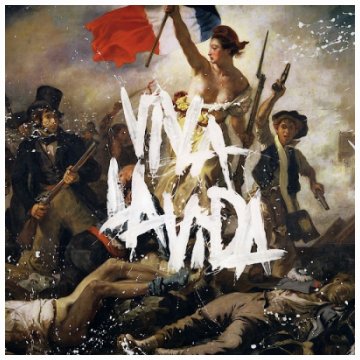
In seeing how this was done we discover further evidence of what is going to unfold when the lawless one is about to be unveiled to the world, which I've been blogging about since the opening ceremonies in Sochi when the Lord began to open it to me. Through association with music videos, their Marian frame (or should I say, Marianne) imports a substantial layer of Illuminati or Monarch trauma-based mind-control programming, which is typical of such Occult works. The programming and antichrist themes are woven and bound together, as I've demonstrated at length on this blog. The music videos of Coldplay's framing songs reveal them as anthems for the Black Awakening, with Mary-Athena-Minerva sponsoring revolution. The theme of revolution will become very evident in this post, which is ultimately the rebellion against the one true God's authority.
(Coldplay fans who drop in and read here and are familiar with another song on the album, Violet Hill, you might want to argue that they are actually anti-war or pacifists. If you learn about symbolism and think about them being doves not hawks, well, there's something to think about that's not contradictory.)
You can watch video of their performances of these songs during the Paralympics ceremony on YouTube.
For some context, I note how Strawberry Swing was a fitting segue for Rihanna's performance on the swing because it offered what must have been a comforting thread of continuity for the audience. That's a pretty thin thread, of course. To know what's really going on you have to look further. In those broadcast versions of both songs there didn't seem to be an abundance of overt goddess symbols. When you see the fire dancing done and magickal drumming for the ritual building of energy, those elements are evidence of the religious context within which Coldplay and Rihanna are performing. The segment is called Summer, and the 4 seasons celebrate the pagan calendar. In the videos you'll see dancing on the stage that bears the markings that look like sigils denoting the Pagan calendar's quarter and cross-quarter holidays. That can be seen as a version of the 8 rayed star of the goddess. The Agitos presented the subtle swoosh of Nike and the crescent moons of the moon goddess, of the night. The Paralympics ceremony had Druidic elements, which you can see from this video found on the YouTube channel for Greywolf, chief of the British Druidic Order. Look for the fire dancer toward the end of it who appeared during Coldplay's performance.
The really obvious goddess connection is made through Coldplay's Grammy Award winning album and the music videos that are associated with those songs. The image of the goddess appears on the cover. The album is their 4th studio album, the “Isis numbering.” The goddess of the cover art is also seen in the official music videos for these songs. I intend to explain the symbolism of the videos in another post.
Marianne
The goddess of Viva la Vida is that of the painting titled, Liberty Leading the People. The following is from Wikipedia.
“Liberty Leading the People is a painting by Eugène Delacroix commemorating the July Revolution of 1830, which toppled King Charles X of France. A woman personifying Liberty leads the people forward over the bodies of the fallen, holding the flag of the French Revolution – the tricolor flag which is still France's flag today – in one hand and brandishing a bayonetted musket with the other. The figure of Liberty is also viewed as a symbol of France and the French Republic known as Marianne.”

If you connect her with America's Lady Liberty (gifted by French Masons) and the Liberty Bell, you do well. Did you notice a bell featured during the videos? Ringing out Liberty, the Marian entity. You may think that we in America, have something completely different from Liberty-Marianne going on. Well, no, but we typically refer to her as Columbia, as you see in this war promotion poster that is of a kind that seems to have fallen out of fashion. Or Freedom, who stands atop the Capitol Dome as her counterpart Minerva on the Capitoline Hill in Rome.
The name, Marianne, is thought by some to have come from a connection with the Jesuit Juan de Mariana, the 16th century Monarchomach who was famously a theoretician of tyrannicide, and that may be so. Still, consider how the name is a combination of Maria and Anne, identifying her with the goddesses Mary and Inanna. The compositing of the goddess names is probably how the Mary worshiping Jesuit also acquired his name.
When Coldplay identifies with the goddess of that painting they are associating with a place and time, Paris in the year 1830. That's where and when “Our Lady of the Miraculous Medal” appeared three times to Catherine Labouré.
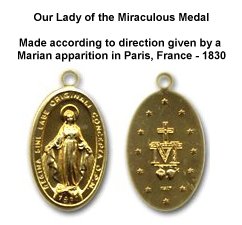 (Probably the inspiration for Baron de Coubertin choosing to award medals to the Olympian athletes - “Our Lady of the Olympics”) Through the symbolic imagery of the adopted work of art, Coldplay honors the Marian apparition, “Our Lady of the Miraculous Medal.” At the same time, she is honored in her role as the goddess of war, and patroness of revolution.
(Probably the inspiration for Baron de Coubertin choosing to award medals to the Olympian athletes - “Our Lady of the Olympics”) Through the symbolic imagery of the adopted work of art, Coldplay honors the Marian apparition, “Our Lady of the Miraculous Medal.” At the same time, she is honored in her role as the goddess of war, and patroness of revolution. If you consider the logic of Coldplay's Occult linking, historically, it falls apart because that revolution was due in no small part to the Romish church pandering King Charles X's imposition of the death penalty for anyone profaning the Eucharist. Esoteric references don't have to make a lot of sense, they just have to establish the essential connections.
Frida
Coldplay's album points to another painting, another nation and another revolution - and more imagery of the same goddess. The album was claimed to have been “recorded in a bakery, a nunnery, a magic shop, a church.” Actually, several churches; in Barcelona, Spain, and in Mexico during their Latin American Tour in March of 2007. A song titled, “Famous Old Painters” was written but wasn't chosen for the album. Eugène Delacroix (Liberty Leading the People) was certainly one famous old painter. Another was Frida Kahlo, Mexico's most famous female artist.
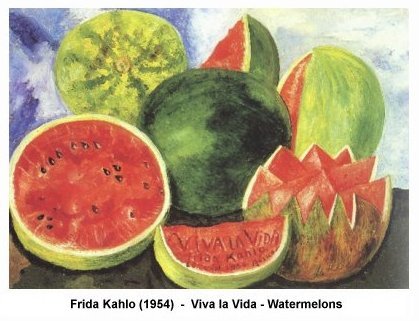
Her final work bore the words, Viva la Vida, and it is with respect to Frida's life that the album's subtitle makes even more sense: Viva la Vida or Death and All His Friends. She was severely injured in a bus accident when she was a teenager. She suffered from those injuries and from the many resulting surgeries until her death. As bringing her suffering to an end, one might consider Death to have come as a friend to her. “A few days before her death, she wrote in her diary: "I hope the exit is joyful — and I hope never to return — Frida". (Wikipedia)” Vida la Vida, means, “Live the Life,” “Long Live life,” “Live the Lifetime,” “Live the Way of Life” or “Live the Lifestyle.”
According to 1 Corinthians 15:26: “The last enemy that will be abolished is death.” That does not seem to have been Frida's hope.
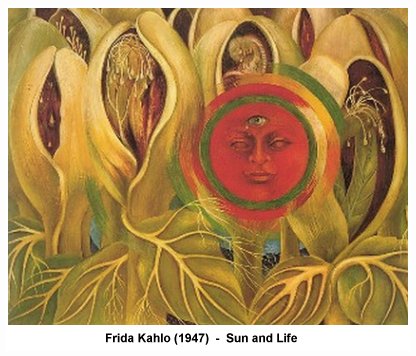 In a work from 1947 titled, Sun and Life, we see an expression of the hope of the illuminated. The open eye in the sun's forehead has to be seen as the eye of Ra or Horus. The page on a fan site describes the scene. “As a result of a terrible bus accident at age 18, Frida was unable to have children. Her obsession with fertility was often the subject of her paintings. In this painting, the life-giving sun is surrounded by plants in the form of erupting male penises and female wombs protecting a growing fetus. This painting also reveals Frida's sadness over her infertility as shown by the weeping sun and fetus.” I suggest rather that the subject is the reproduction of the Tree of Knowledge of Good and Evil in the earth through the mystical union of Osiris and Isis. This is akin to resurrection, and to the illuminated, it is their hope of eternal life.
In a work from 1947 titled, Sun and Life, we see an expression of the hope of the illuminated. The open eye in the sun's forehead has to be seen as the eye of Ra or Horus. The page on a fan site describes the scene. “As a result of a terrible bus accident at age 18, Frida was unable to have children. Her obsession with fertility was often the subject of her paintings. In this painting, the life-giving sun is surrounded by plants in the form of erupting male penises and female wombs protecting a growing fetus. This painting also reveals Frida's sadness over her infertility as shown by the weeping sun and fetus.” I suggest rather that the subject is the reproduction of the Tree of Knowledge of Good and Evil in the earth through the mystical union of Osiris and Isis. This is akin to resurrection, and to the illuminated, it is their hope of eternal life. Frida identified herself with the Mexican Revolution, which began in 1910 when she was three years old. “Frida Kahlo was born on July 6, 1907, in her parents' house known as La Casa Azul (The Blue House), in Coyoacán. At the time, Coyoacán was a small town on the outskirts of Mexico City.” “She later gave her birth date as July 7, 1910, allegedly wanting her birth to coincide with the beginning of the revolution so her life would begin with the birth of modern Mexico.” (Wikipedia) See Frida as a symbol of revolution that compares to the goddess of Delacroix's painting. She was born in July and identified herself with the Mexican Revolution, and also died in July, and the album art pictured the July Revolution.
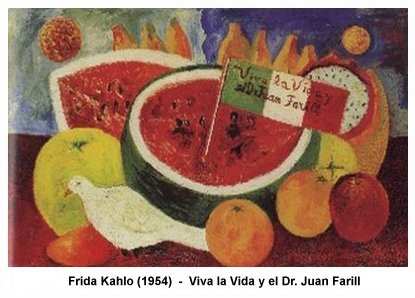
While the last painting Frida did was to apply the label, Viva la Vida to the still of watermelons (that had most likely been painted a couple of years before the pain medications exacted their toll), the stronger association with the cover art is with another painting of hers where the words appear on a flag - one much like the one borne by Liberty: “Still Life - Viva la Vida and the Dr. Juan Farill - 1954.” In this, we see the distinctive goddess symbol of the dove: Aphrodite-Venus-Mary! There she is!
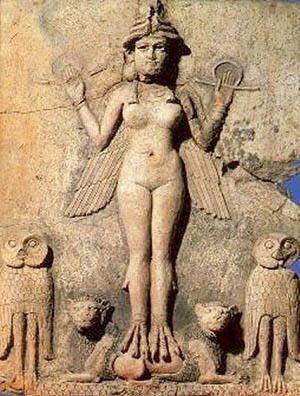
Frida was known to embed subtle symbolic imagery in her paintings, much of it sexual. I believe she encoded the ancient goddess symbol into her Viva la Vida watermelons, the simple W that represents the bent elbow of the goddess Inanna-Ishtar.
In the Lifetime network TV series, Witches of East End, the witch named Freya is a barmaid at The Bent Elbow Bar. “Inanna was also associated with beer, and was the patroness of tavern keepers, who were usually female in early Mesopotamia.” (source) Lots of dots, connecting.

 Find the W in the highest section of the wave-cut melon, and centered below. Hey, is that a dove in flight at upper left? It's subtle. That fancy cut watermelon is a goddess crown. The wave form glyph represents water - Venus. It is a WATER melon. The goddess is usually bare breasted and the breasts are referred to melons, right?
Find the W in the highest section of the wave-cut melon, and centered below. Hey, is that a dove in flight at upper left? It's subtle. That fancy cut watermelon is a goddess crown. The wave form glyph represents water - Venus. It is a WATER melon. The goddess is usually bare breasted and the breasts are referred to melons, right? 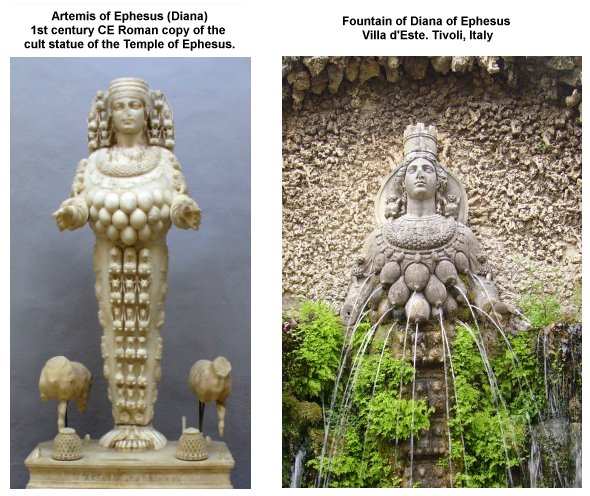
Compare Frida's Watermelons to the images of Artemis-Diana of Ephesus. Melons. The goddess's mammary attributes are likened by some to a queen bee's eggs and also bull's testicles.
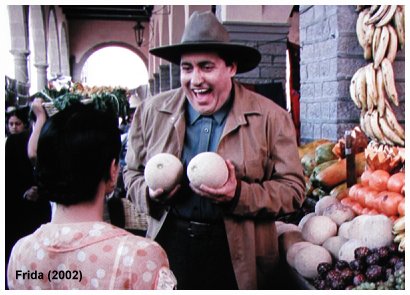 The exposed seeds in the Frida's painting are probably intended to represent the bull's testicles, fertile with seed. The male and female fertility imagery really is a strong thread that runs through her work.
The exposed seeds in the Frida's painting are probably intended to represent the bull's testicles, fertile with seed. The male and female fertility imagery really is a strong thread that runs through her work. I just finished watching the Salma Hayek film based on her life titled, Frida, from 2002. In this screenshot, Frida and Diego are in the market. He's holding up the melons as breasts. Right after this, he puts those down and picks up some other kind of produce and jokes around with Frida pretending it represents big cojones, testicles.
The W signal is modeled all over the place in our culture. It's very obviously featured in the choreography of goddess modeling bent elbow pose striking women in music videos. The W and also an M (and E) is formed in the Horus hand sign that joins fingers 3 and 4 together. That's also the cloven hoof sign of Satan.
 Sometimes the single V symbol is used for Venus and Victory, the goddesses. (Winston Churchill) Sometimes it's doubled to form V+V or W, like how Taylor Swift hand signals the VV or W in performing “22,” which happens to be the number of the letter V. In this image, she crosses her hands to make the double V. Crossing them forms another V between them. Triple V = vav (6th Hebrew letter) vav vav = 666.
Sometimes the single V symbol is used for Venus and Victory, the goddesses. (Winston Churchill) Sometimes it's doubled to form V+V or W, like how Taylor Swift hand signals the VV or W in performing “22,” which happens to be the number of the letter V. In this image, she crosses her hands to make the double V. Crossing them forms another V between them. Triple V = vav (6th Hebrew letter) vav vav = 666. While I'm at it, “Viva la Vida” has 3 letters V = 666. (LA = 12+1=13) But “Viva la Vida” also features pairings of V's, the double V or W. Coldplay's Album cover art lines two up vertically. The Youtube channel Vevo ~ double V- goddess exalting. “Vevo Video” is a triple V 666.
“Frida (with variants Frieda, Freida and Freda) is a feminine given name. In Scandinavian countries, it derives from the Old Norse name Fríða, meaning "beautiful, beloved". In central and eastern Europe, Frida is a short form of compound names containing the Germanic element fried meaning "peace".” (Wikipedia) Freya is the name of the Norse queen of the gods, the goddess of love, beauty, war and death. The goddess symbol identified with the Mexican revolution is referenced through the album title, Viva la Vida, and that same goddess of the French Revolution of 1830 is referenced through the album cover art.
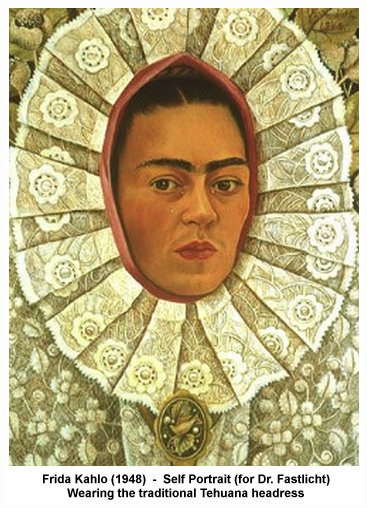
Frida painted an elaborate self-portrait in 1948 that presents her as the goddess. It's the second self-portrait in which she appears wearing the traditional Tehuana headdress. Its the resplandor or head-dress that is traditional for Tehuanas, women of Tehuantepec. They were strongly matriarchal, and Frida, who was certainly feminist, and bisexual, expressed solidarity with them. Her mother Matilde's heritage was mixed indigenous-Spanish, and Matilde was a devout Roman Catholic. According to a fan site's description of the painting, “The years of pain have taken their toll as is shown by three tears glistening down her cheeks like the tears of the Madonna of Sorrows.” The Madonna of Sorrows - that's Mary.
Count the upper panels formed in the radial pleating of Frida's Tehuana headdress. There are 13, which has the meaning of rebellion. Mary's name means, “their rebellion.”
The following verse is where the number appears in the biblical text for the first time.
Twelve years they served Chedorlaomer, and in the thirteenth year they rebelled. ~ Genesis 14:4

They rebelled. It was a revolution, in the 13th year. Who is Coldplay's goddess of the revolution? Mary!
The number 13 is naturally connected with Venus through the design the planet traces in the heavens. A 5 point star pattern called the Rose of Venus is traced out over the span of 8 earth years, exactly, to the day. In that span, Venus makes 13 circuits around the sun. See in Frida's self-portrait how her face is framed in a rosette - the Venus Rose. Consider the rosettes in the lace. The numbers generated in the creation of the Venus Rose are, 5, 8 and 13. These represent a range of the Fibonacci sequence, and this is why the spiral is a symbol of the goddess. The 5 pointed star in a circle reveals why the pentagram is another one of her symbols.
Frida's mother, Matilde, was a devout Roman Catholic, and even though I don't read where Frida practiced her mother's religion,
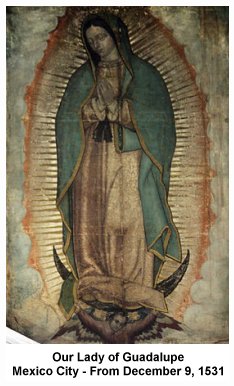 she would certainly have been exposed to the Marian Rosary and candle burning acts of veneration. Frida was born, lived and died in The Blue House in Coyoacán, just southwest of Mexico City. The Marian apparition known as Our Lady of Guadalupe had appeared in 1531 a few miles away, just northeast of Mexico City. Would her mother and others in her community have made the short pilgrimage to her wildly popular shrine? This would have been a normal part of their culture. I note how Matilde's heritage, and therefore her daughter's also, matched a feature of that apparition. Matilde was of “mixed Amerindian and Spanish ancestry.” One of the miraculous signs given by Our Lady of Guadalupe involved the Castilian (Spanish) rose growing in the land of the “Amerindian.” From Wikipedia:
she would certainly have been exposed to the Marian Rosary and candle burning acts of veneration. Frida was born, lived and died in The Blue House in Coyoacán, just southwest of Mexico City. The Marian apparition known as Our Lady of Guadalupe had appeared in 1531 a few miles away, just northeast of Mexico City. Would her mother and others in her community have made the short pilgrimage to her wildly popular shrine? This would have been a normal part of their culture. I note how Matilde's heritage, and therefore her daughter's also, matched a feature of that apparition. Matilde was of “mixed Amerindian and Spanish ancestry.” One of the miraculous signs given by Our Lady of Guadalupe involved the Castilian (Spanish) rose growing in the land of the “Amerindian.” From Wikipedia: “The Virgin told Juan Diego to gather flowers from the top of Tepeyac Hill. Although December was very late in the growing season for flowers to bloom, Juan Diego found Castilian roses, not native to Mexico, on the normally barren hilltop. The Virgin arranged these in his peasant cloak or tilma. When Juan Diego opened his cloak before Bishop Zumárraga on December 12, the flowers fell to the floor, and on the fabric was the image of the Virgin of Guadalupe.”
Note: “Tepeyac is believed to have been a Pre-Columbian worship site for the indigenous mother goddess Tonantzin. Spanish colonists tore down a temple to her and erected a Catholic chapel at the site.” (Wikipedia)
It seems likely that Coldplay sees Frida as a model of the goddess, as the Castilian Rose (Venus) growing miraculously in Mexico, who is associated with Our Lady of Guadalupe.
 It also seems likely that Coldplay has noted the other esoteric details surrounding her death, which has to be seen in connection with the album's subtitle. She painted the referenced expression, Viva la Vida, 8 days before her death, stamping it with the number of the rayed star of Venus. She died on July 13, 1954 at age 47. Her life span recalls the 47th Problem of Euclid. Osiris union Isis producing Horus. (See above ) The theme of immortality, death and resurrection is evident. Her death on the 13th day of July seems worth noting as another Venus-Marian numbering. I note that both of the singles they performed during the Summer segment had release dates on the 13th day of the month The single, Viva la Vida, was released on 13 June 2008 as the album's second single, and Strawberry Swing was released as the fifth and final single on 13 September 2009. The 13th day of the month is the day favored by Marian apparitions like at Fátima, and in the US in regular appearances to Rosa Lopes, Nancy Fowler and Ray Dorian.
It also seems likely that Coldplay has noted the other esoteric details surrounding her death, which has to be seen in connection with the album's subtitle. She painted the referenced expression, Viva la Vida, 8 days before her death, stamping it with the number of the rayed star of Venus. She died on July 13, 1954 at age 47. Her life span recalls the 47th Problem of Euclid. Osiris union Isis producing Horus. (See above ) The theme of immortality, death and resurrection is evident. Her death on the 13th day of July seems worth noting as another Venus-Marian numbering. I note that both of the singles they performed during the Summer segment had release dates on the 13th day of the month The single, Viva la Vida, was released on 13 June 2008 as the album's second single, and Strawberry Swing was released as the fifth and final single on 13 September 2009. The 13th day of the month is the day favored by Marian apparitions like at Fátima, and in the US in regular appearances to Rosa Lopes, Nancy Fowler and Ray Dorian.Next up - Lord willing - the symbolism of the music videos.

Hay Bob, great work. News is crazy. Several of pics i've looked at show multiple corners of sections of un burned wreckage are bent outwards. My guess is the bomb was onboard plane mh17. Just like Beirut barracks bombing '83.
ReplyDelete